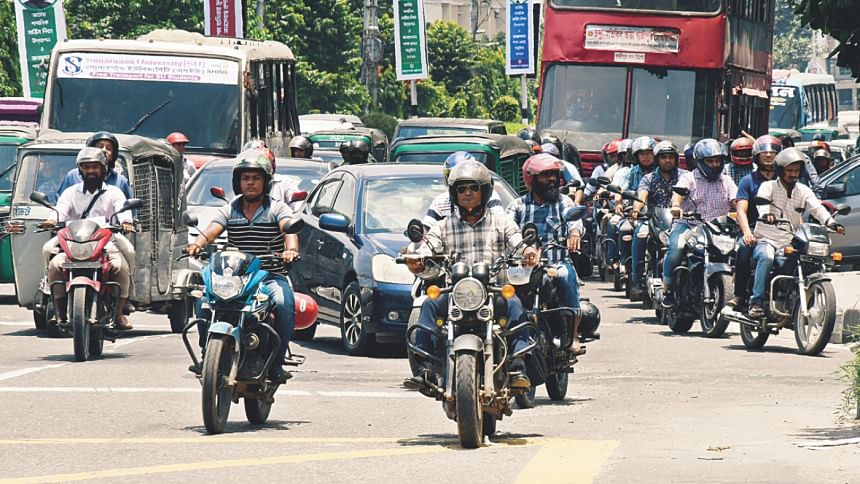The motorcycle boom in Bangladesh

The motorcycle industry has been growing fast in Bangladesh, thanks to government policy support and people’s growing purchasing power, market players said.
Introduction of ride-sharing services in Dhaka and Chattogram in recent years has also contributed to a rise in demand for motorbikes.
Market insiders said around 5 lakh motorcycles were sold in FY2018-19, up 25 percent from 4 lakh a year ago. It means nearly 1,500 motorcycles are being purchased every day.
Assuming the price of a motorbike is Tk 100,000 on average, total sales figure in monetary terms would be around Tk 5,000 crore, which is almost equivalent to the market size of the four-wheeler.
This high demand has encouraged market players to set up either manufacturing facilities or assembling plants to reduce prices and have a bigger share of the growing market. Around 80 percent of motorcycles running in the country have either been locally manufactured or assembled.
“Continuation of concessionary duties on import of raw materials is helping the sector grow rapidly,” said Hafizur Rahman Khan, chairman of Runner Automobiles, the first local company that began manufacturing motorbikes in the country more than a decade ago.
Khan, also president of the Bangladesh Motorcycle Manufacturers and Exporters Association, said development of backward linkages is vital for capacity expansion of motorcycle manufacturing.
But he urges for long-term policy, including tax measures, as changes of rules every year may hurt investors badly.
Khan said the government has no policy on local vendors who supply components to the manufacturers.
“If the government prepares a long-term policy for the automobile sector, the investors would be very much at ease and foreign investment would flow into this sector,” he said.
According to industry insiders, Indian brands like Bajaj, TVS and Hero dominated the market, but other players such as Runner, Honda, Yamaha, Suzuki and Mahindra are also making a mark.
Sector players said annual sales would cross 15 lakh units by 2025.
According to them, Bangladesh has been a very good market for motorcycles, with even the premium segment growing as much as 30 percent year-on-year.
Abdul Matlub Ahmed, chairman of Nitol Niloy Group which manufactures Hero Motorcycles, believes within the next three years the annual sales would reach 7 lakh to 8 lakh units because of the government’s policy support.
Ahmed said within the next five years, Bangladeshi motorcycles would be exported to the northeastern states of India, Nepal and Africa as manufacturing capacity would increase while price would come down.
According to him, the annual sales amounted to only 1.5 lakh units in FY2014-15 and have now increased by almost two and a half fold.
“This sector has big potential in Bangladesh but it is really tough to set up a manufacturing plant due to the need of a huge amount of investment and a centre for research and development,” he added. As such, joint venture manufacturing plants are risk-free for making businesses viable, he said.
He said this sector created around 50,000 jobs and it would create around two lakh jobs within five years.
Robiul Haque, business manager of ACI Motors that distributes Yamaha in Bangladesh, said locally assembled motorbikes’ price is 20 percent to 24 percent lower than that of imported bikes.
He appreciates the government for formulating a policy on two-wheelers that would help the industry to manufacture 10 lakh units by 2027.
“I believe the government’s target of manufacturing two-wheelers will be met within the next five years before three years target,” he said.
Haque said the price will reduce significantly when most of the brands manufacture in Bangladesh as the government provides duty facilities.

 For all latest news, follow The Daily Star's Google News channel.
For all latest news, follow The Daily Star's Google News channel. 



Comments